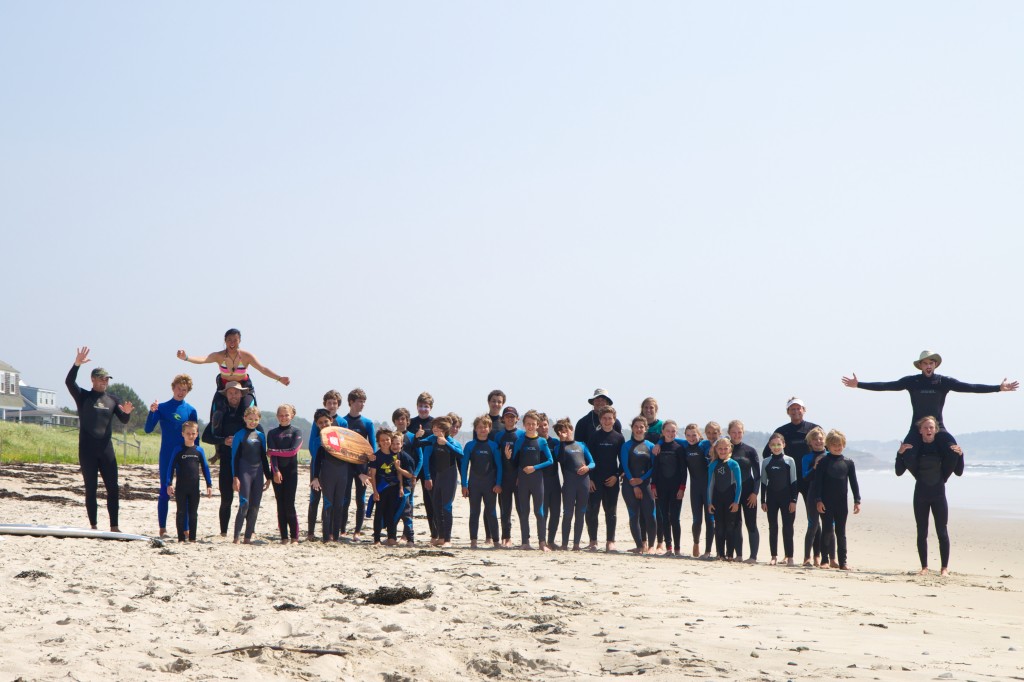maine surfing
maine surfing - Blog Archives
August 8th, 2014
Session #6 Surf Camp Photos
Somewhat smaller waves this week compared to last, nevertheless, did not disappoint. It was sunny and hot for most of the week and there were plenty of waves out there for everyone to have a great time. You can view and download images from the full gallery here: Surf Camp 2014 Week #6 Photo Gallery

Above: Sawyer leads us through the morning meeting. “I caught a fish like, this big.”
Below: STOKED!
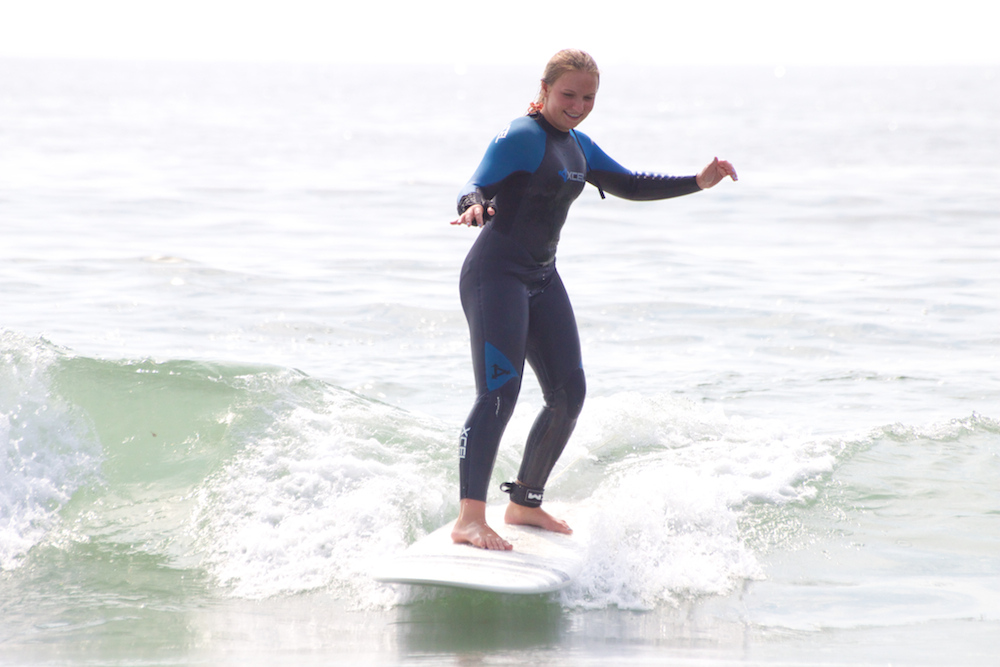
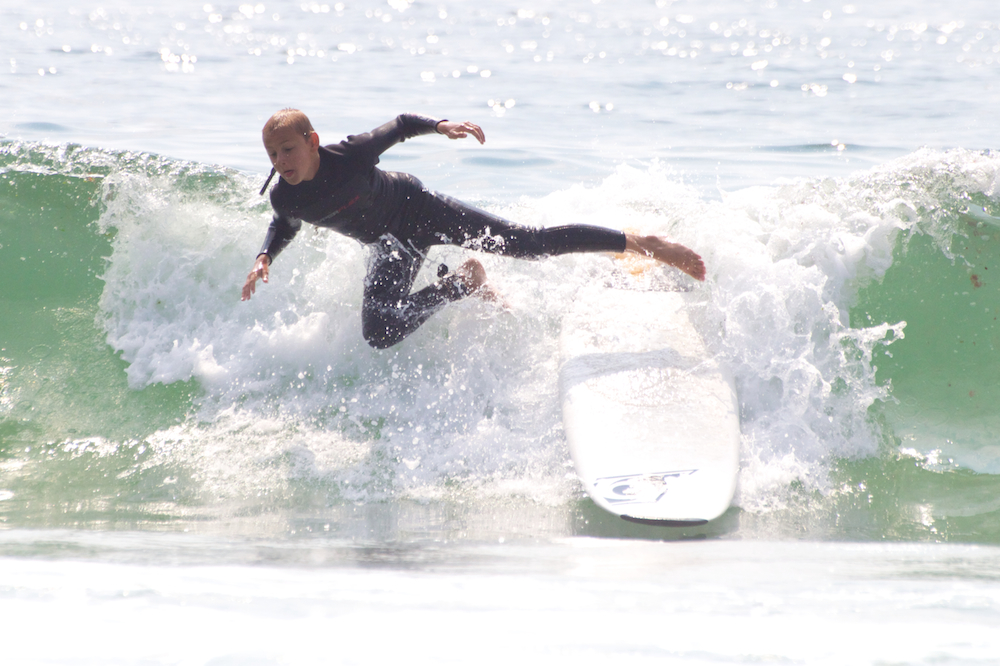
Above: This surf camper was sure he’d spotted buried treasure. He just missed it on the dive!
Below: Group photo with Prout’s Neck in the background.

Tags: learn to surf, maine surfing, summer camp, surf camp, surf lessons, surfing photos
July 20th, 2014
Surf Camp Photos from Weeks 3 and 4
The waves for weeks #3 and #4 of Surf Camp provided non-stop fun. We had light winds and sunny skies to make the small but consistent pulse of swell a perfect mid-summer treat. There wasn’t much time spent out of the water in either week.
- Surf Camp 2014 Week #3 (July 7 – 11) – Full Gallery
- Surf Camp 2014 Week #4 (July 14 – 18) – Full Gallery

Above: Can you beat this? Warm water, sunny skies, glassy waves = GOOD TIMES!
Below: Surf instructor Sawyer Theriault cruising the nose on a nice little runner.

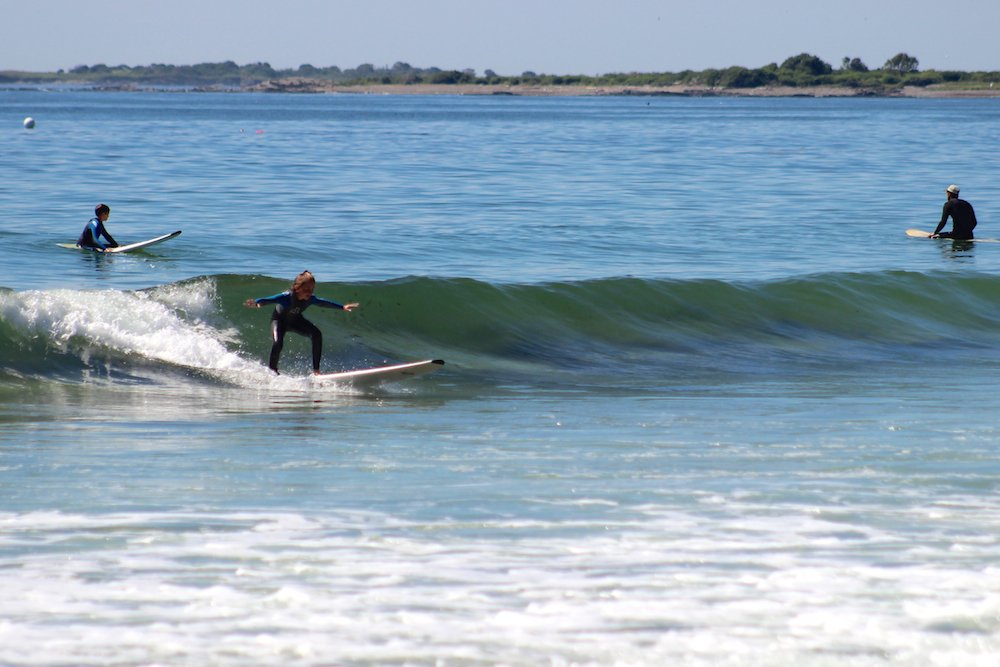
Above: When it comes to learning to surf, waves like this are pretty much perfect.
Below: Instructor Emily Heath navigating some fun lines at Scarborough Beach.
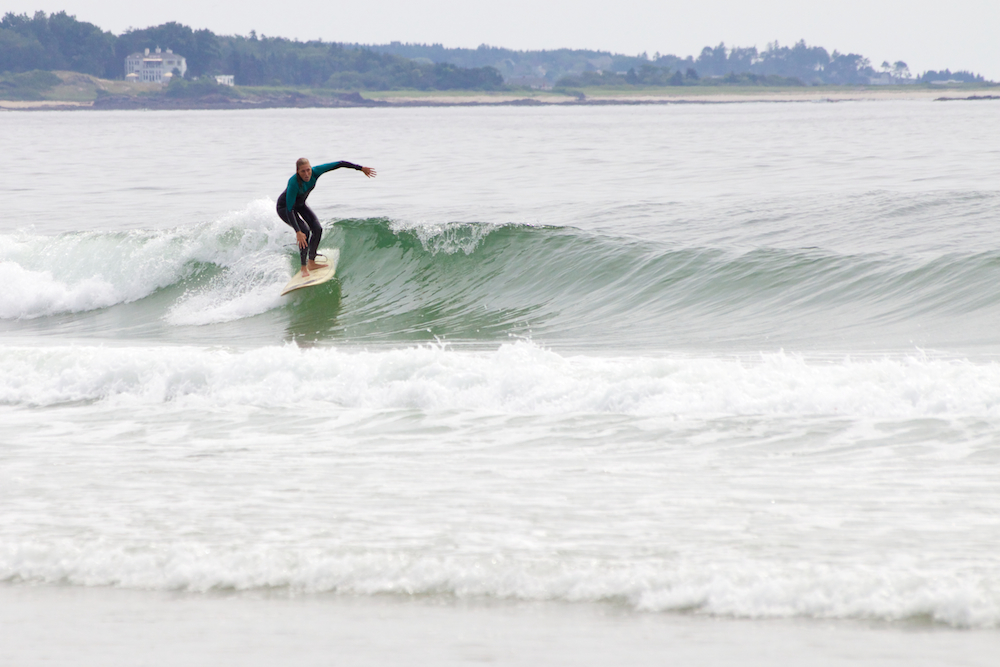
Tags: learn to surf, maine day camp, maine summer camp, maine surfing, surf camp
July 13th, 2014
Photos from Week #2
The second week of Surf Camp did not disappoint… so far this has been an above average summer for waves and weather, and the kids are loving it! So are we… images link to full gallery and downloads.
Tags: maine surfing, session #2, surf camp, surf lessons
June 30th, 2014
2014 Kicks Off With Great Weather, Fun Waves
With the 2014 season of Surf Camp now underway, the first week of camp launched us off in good form with beautiful weather and fun waves throughout the week. We visited Sprague Hall on Thursday morning to avoid a thunderstorm and kick back with a movie, but otherwise it was sunshine all week. Check out the photos here:
Tags: camp photos, maine surfing, surf camp 2014, surf photos
January 25th, 2009
Learn To Surf: Top 5 Tips
Keep these tips in mind while you’re learning to surf and you’ll be shredding it up sooner then you ever imagined!
Tip #1: Have the Right Gear
Make sure you have the right surfboard and and a properly fitting wetsuit (or trunks) when you are first learning to surf. Even though the Pro’s on TV and in surf movies almost always ride short boards (generally anywhere from 5’6″ – 7’0″), there is nothing worse than trying to learn to surf on a board that is too small.
For adults learning to surf, a good board size is a minimum of 8’6 and up to 10′. Once you get comfortable riding a longboard, you can gradually move down in size if your goal is to ride a shorter board… but you will only frustrate yourself if you try to learn on one!
It’s also important to where a wetsuit that fits properly (if one is required). A suit that is too big will rub uncomfortably and can cause nasty rashes and even bleeding; not to mention, it will make it much harder for you to paddle and stand up!
A wetsuit should fit tightly and if in doubt, it’s better to have one a little too small than too big (it will keep you warmer too).
Tip #2: Paddling Technique
Paddling is the most important skill in surfing! If you can’t paddle your surfboard well you won’t be able to catch waves, and you’ll get tired quickly. Your “paddling muscles” — think shoulders, arms, and back — take time to get strong just like all the other muscles in your body.
While you are still learning to surf, you should make a habit of doing a paddle warm up every time you get in the water.
Practice by paddling out past the lineup and going around a nearby buoy or just paddling up and down the beach when it’s flat. Good technique while paddling is also important; try to paddle so that your hands reach far out in front of you and stay close to the rails of your board, digging down deep into the water with each stroke. In surfing, it’s not about how fast you paddle but how much energy you get out of each stroke.
Tip #3: Arch Your Back
When surfing, form is key. Both when you are paddling and catching waves, arching your back will make sure that your weight is properly distributed on your board. It will help you avoid tiring but common occurrences when you are trying to learn to surf, such as the “nose dive.”
By keeping your head up you’ll also be able to spot potential waves more easily. The sign of an experienced surfer is that they keep there head up and back arched while paddling — the most common thing you’ll hear a Surf Camp counselor yelling while at surf camp is “arch your back!”
Tip #4: Hand Placement
This tip goes hand-in-hand with Tip #3. While you learn to surf, your impulse will be to grab the rails of your surfboard when you “pop up” to get to your feet… but don’t do it! By grabbing your rails you throw off the balance of your surfboard instead of allowing it to plane evenly over the surface of the water.
When you are about to pop up (and arching your back — see Tip #3!), you should place your hands on top of the deck of the board next to your shoulders.
Remember this tip along with Tip #3 while you’re in the water and you’ll find yourself catching — and making — a lot more waves!
Tip #5: Go Knee-Less
Everyone is guilty of this at first… standing up on your board using your knees (or knee). By using your knees when you pop up you make yourself more off balance and also throw off the balance of your surfboard.
This common mistake also adds a clumsy step right in the middle of the most crucial part of your take off. This step takes practice, but if you keep trying to go straight to your feet without using your knees it will quickly become a habit and take your surfing to the next level.
If you have to use your knee at first (we all did) that’s O.K., but don’t make it a habit! This is actually one of the easiest parts of surfing to practice because you can do it on dry land. Just draw yourself a surfboard in the sand and give it a go!
Use your arms to push your upper-body off the ground (and arch your back), and in one fluid motion try to hop to your feet just like you are on a board — it’s sort of like trying to do the worm!
If you get this down though, it will open up a whole new realm of surfing and you’ll be able to take off on faster and bigger waves.
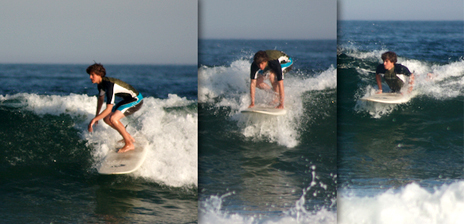
Here’s a good example of tips 3, 4, and 5 all put together to form a perfect pop-up
Just remember, these things may not (and probably will not) be easy at first, but as long as you practice the right techniques you’ll be on your way to becoming the next Kelly Slater (or at least a better surfer…).
Get in the water with a friend so you can remind each other of these simple surfing tips while you’re learning.
What’s the next step to surfing success? The experienced surfers at Surf Camp who wrote these easy tips have a lot more to teach you when you come to Surf Camp or sign up for a private or group Surf Lesson.
Tags: how to surf, learn to surf, maine surfing, surf tips, top 5 surf tips
January 23rd, 2009
Frequently Asked Questions
How hard is it to learn to Surf?
Over nearly a decade of teaching kids and adults of all ages, shapes, and sizes how to surf, we’ve learned something about surfing: anyone can learn to surf! Usually we have most kids standing up and riding waves by the end of their first day, and by the end of the week everyone is riding waves on their own!
Just like any sport, surfing takes practice! Unlike many other sports though, surfing is something that an individual can carry with them throughout their entire life. In surfing, everyone is always learning. The ocean is a constantly changing phenomenon which means surfers are always adapting to ever-changing conditions.
Do people really surf in Maine?!
Yes! Can you believe it? Maine has a large and dynamic surf community composed of dedicated surfers who surf not just in the summer, but throughout the fall and winter seasons.
Scarborough Beach, located on scenic Prouts Neck in Scarborough, Maine is a perfect place to learn to surf in the summer. Despite the fact that on TV and in the movies surfing is all about big waves and crazy tricks, the reality is that learning to surf is much easier in the friendly environment that Scarborough Beach provides.
In an average week we have a great variety of waves to help our campers learn in all conditions. Smaller waves to learn the basics of paddling and the “pop-up,” and as the week goes on our campers get the opportunity to practice their new surf skills in bigger waves.
The other great thing about learning to surf in Maine is the weather… A Maine beach really is the best place to spend time in the summer! Even though we encourage our campers to use wetsuits, they usually love the chance to take them off and head into the warm water in just their board shorts. With miles of soft sandy beach, there is lots of room for the whole camp to spread out and catch waves!
I’ve taken a lesson before or have prior surf experience… what will I learn at Surf Camp?
Surfing is a sport that many people carry with them until the day they die. There is always more to learn! Our staff of surf instructors are some of the most experienced and talented surfers in the region. With expertise from exotic surf destinations all over the world, we can provide advanced surf instruction, including working on maneuvers such as airs, cutbacks, nose rides, and snaps, to surfers of all experience levels.
It is also not uncommon for us to get some pretty great surf during a typical week! We’re often in the water with surfers getting the rides of their life in clean and beautiful surf conditions.
What should I bring to Surf Camp?
You should plan to bring the following every day to camp:
- Beach towel
- Warm sweatshirt
- Sunscreen
- Good Lunch!
- Sandals
- Sunglasses
- Backpack/bag
- Long pants & Socks for rainy days
You may also bring a rash guard or your own wetsuit (if you have either), an extra t-shirt/shorts, or other beach toys/games/equipment that you might want to use. You may bring your own surfboard, but generally if it does not have soft fins (such as the rubber Pro-Teck fins we use) we won’t let you use it with camp. Some campers also like to bring their Skim Boards!
January 23rd, 2009
Scarborough Leader Interview
By Amanda Estes – Scarborough Leader 2007
When people ask David Turin where he surfs in Maine, his tongue in cheek response is, “Sebago Lake, where do you think?”
Although Maine’s beaches may not be a draw for big wave surfers, Turin said the state has a respectable surfing community. As the co-founder and director of Surf Camp at Scarborough Beach, Turin is at the center of that community, bringing seasoned instructors together with wannabe surfers of all ages via a day camp and private lessons.
At the start of each session, Turin tells his campers that surfing is all about having a good time. When he asks them who they think the best surfer in the world is, he said, their answer is usually Kelly Slater, a world champion several times over. Turin gently corrects them and says the best surfer is the person who is having the most fun.
 A restaurant owner and chef, the Cape Elizabeth resident has been surfing for 15 years. Although he has been around water all of his life, Turin said he was a late bloomer. When he starting surfing at Higgins Beach, Turin said he was “bitten like a child about it.”
A restaurant owner and chef, the Cape Elizabeth resident has been surfing for 15 years. Although he has been around water all of his life, Turin said he was a late bloomer. When he starting surfing at Higgins Beach, Turin said he was “bitten like a child about it.”
He said he prefers long boarding, but he will use a shorter board when the conditions are right. Short boards he said are best for the steep, fast waves that attract “big wave junkies.”
“Long boarding is like going cruising in comparison to riding short board,” he said. He joked that short boarding is for rubber people.
Turin said they mostly teach long boarding in the camp and the private lessons. Adults are slower learners, hindered to some extent by inflexible bodies and fear, but Turin said most kids will stand up on the board within their first hour of camp. He has never had a camper, who didn’t stand up within the first week, he said.
Potential surfers worried about chilly Maine waters needn’t worry as all campers are outfitted with wet suits. Turin, who hits the beach during the winter months, said surfing in Maine is “all about having the right gear.” Despite having to wear wet suit boots and gloves, Turin said he prefers the cooler water because when the water is too warm it is difficult to get cooled off.
Part of learning to surf is learning about the world of surfing etiquette. According to the New England Surf Web site, that means following a surfer’s code of conduct to determine who has the right of way in different situations. Turin said the most common surfing injuries result from a collision with someone else or one’s own board.
“Statistically, surfing is safer than golf,” Turin said. He said in his 15 years, his most serious injury was a sprained muscle. Turin said when people think of surfing, they usually think of the surfing they see on television. The Banzai Pipeline, on the north shore of Oahu, Hawaii, is perhaps the most famous of surfing spots. Turin said Pipeline lifeguards usually perform 1,500 rescues a year. Lifeguards at Scarborough Beach perform an average of 10 rescues per year.
“People want to see the extreme situation, ”Turin said. “They don’t want to see family day on the beach.”
Turin said waves over 10 feet high don’t interest him much. He is more interested in waves that are head high or a foot or two over head. The National Weather Service has offered surfers a tool for checking the day’s surf. Turin said the National Weather Service tracks wave height, wave periods, wind direction and swell direction. When there is big surf at Higgins Beach, Turin said there can be up to 130 people hoping to catch a wave.
He may not be an extreme surfer, but Turin has certainly spent his share of time traveling the world in search of new breaks. He has surfed his way up and down both the east and west coasts as well as several different countries including Fiji and Costa Rica.
When traveling to new places, where each break brings new conditions, Turin said he prefers to travel with a group of people. In Fiji, his group stayed at a surfing resort so they had a guide to point out reefs, but in Costa Rica he said there was maybe only one person who had been there before and on the west coast of the U.S., Turin said there were areas where he didn’t know the area and judged the conditions by the number of people in the water.
Leaving Scarborough’s beach break, in which the waves break up and down the beach and hold large groups of people easily, can be a wake up call as Turin said the local surfers in other parts of the world can be less than friendly. Especially in areas with well defined point breaks or a spot where the wave breaks every time, Turin said local surfers can be very protective of their beach.
Respecting the locals and the environment is part of the surfing etiquette that Turin instills in the campers.“Being a surfer is being a friend of the ocean,” he said. In between the morning and afternoon surf sessions, campers also have the opportunity to learn about marine life. Turin said they have come across seals, birds covered in oil and even dolphins. He said campers become more “aware that the ocean is a changing place.”
For his own part, Turin said surfing has changed the way he lives his life. He said he feels more connected to the world around him. Surfing has undoubtedly also brought him closer to his family as he taught his four children to surf.
Turin stressed that Surf Camp is not a competitive program, but rather it is a fun opportunity for kids to try a new activity. When campers tire of surfing, there are plenty of other activities including water games, boogie boards, volley ball, soccer, ultimate Frisbee and sand castle building contests. With 65 percent of the spots filled with repeat campers, however, it appears that the campers develop a passion for the sport.
Tags: interview, maine surfing, Press, scarborough beach, surf camp




